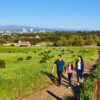
With the ongoing threat posed by California wildfires, be sure you have made a plan should a fire strike in your area. Make sure you know where the fire alarms, smoke detectors, hoses, and escape routes are in your apartment community. Typically, the escape plans are posted in the stairwells and/or near the elevators.
On a higher floor? Where are the stairs and if they are blocked by fire or smoke, do you have an alternate exit strategy? Count the number of doors between your apartment and the nearest exit, and memorize the number in case you have to evacuate in the dark.
Here are some apartment evacuation best practices
- Don’t rush out into the hallway. Feel the door with the back of your hand, and if it feels hot, find another way out.
- Use the stairs, not the elevator.
- Close all doors behind you as you escape to slow the spread of the fire. Do not prop doors open.
- Listen carefully to any announcements broadcast over loudspeakers, or communications via text from community management.
- If you’re unable to escape, stuff wet towels or linens around the door, and call the fire department to tell them where you are. If possible, open the window and signal for help.
- Once out of the building, stay out. If you think someone’s trapped inside, notify the fire department.
Have kids, spouses, roommates who live with you? Keep a checklist such as this one handy and make sure everyone you live with has a plan for where to meet should a disaster strike when you’re not together. For wildfires specifically, open parking lots away from trees is a safe bet.
Have an Emergency Kit
While you can certainly order an emergency kit online, it’s always good to have:
- Bottled water
- Non-perishable snacks
- Face masks
- Flashlights
- Cash
- A whistle
- Batteries
- Matches, lighters
- A pocket knife
- Phone chargers
- Battery-operated radios
- First aid items: burn cream, gauze, aspirin, scissors, sanitary wipes, gloves, and antibiotic cream
 Got Pets?
Got Pets?
Make sure you have a carrier(s) for your pets. You’ll need to include your furry friends in your evacuation plans. The ASPCA mobile app can also help you manage your pet’s health records, and provide you with resources to help you find a lost pet should you get separated. And of course, make sure your pet is microchipped!
What to Bring When You Evacuate
If you have time to pack, it’s good to keep all of your important documents in one place so that you can just grab a single folder. Keep these in a plastic, waterproof case. You may need to prove who you are, so it’s important you carry identification with you always. Items to consider packing may include:
- Driver’s license
- Proof of insurance
- Medical records
- Passports
- Social security cards
- Birth certificates
- Important phone numbers/contacts in case you lose your phone, it’s damaged or out of charge
- Phone or devices necessary for communication
- Chargers for your phone or devices
Don’t Run on Fumes
During August and entering into the fall season, California tends to enjoy warm days, cool nights, and even storms which can often bring dry and gusty winds notorious for driving wildfires. During the California wildfire season, always have at least half a tank of gas. If you have to leave in a hurry and get stuck in traffic trying to flee, running out of gas can really make a bad day, worse.
After the fire
Only re-enter the building to assess the damage and collect any personal belongings once you’ve gotten permission from a fire officer as well as community management. Apartment communities like Irvine Company Apartment Communities have resident apps that make resident communications simple and immediate so you’re always in the know.
Helpful Resources:
The FEMA mobile app sends you notifications about natural disasters from the National Weather Service.

 Got Pets?
Got Pets?





